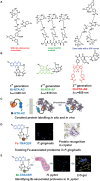Recognition of Proteins by Metal Chelation-Based Fluorescent Probes in Cells
- PMID: 31448265
- PMCID: PMC6695521
- DOI: 10.3389/fchem.2019.00560
Recognition of Proteins by Metal Chelation-Based Fluorescent Probes in Cells
Abstract
Fluorescent probes such as thiol-reactive and Ni2+-nitrilotriacetate (NTA) based probes provide a powerful toolbox for real-time visualization of a protein and a proteome in living cells. Herein, we first went through basic principles and applications of thiol-reactive based probes in protein imaging and recognition. We then summarize a family of metal-NTA based fluorescence probes in the visualization of His6-tagged protein and identification of metalloproteins at proteome-wide scale. The pros and cons of the probes, as well as ways to optimize them, are discussed.
Keywords: His-tag; metallomics; metalloproteomics; molecular imaging; thiol-reaction.
Figures


Similar articles
-
Lighting Up and Identifying Metal-Binding Proteins in Cells.JACS Au. 2024 Nov 29;4(12):4628-4638. doi: 10.1021/jacsau.4c00879. eCollection 2024 Dec 23. JACS Au. 2024. PMID: 39735929 Free PMC article. Review.
-
Rapid labeling of intracellular His-tagged proteins in living cells.Proc Natl Acad Sci U S A. 2015 Mar 10;112(10):2948-53. doi: 10.1073/pnas.1419598112. Epub 2015 Feb 23. Proc Natl Acad Sci U S A. 2015. PMID: 25713372 Free PMC article.
-
A Ni-NTA-based red fluorescence probe for protein labelling in live cells.J Mater Chem B. 2017 Feb 14;5(6):1166-1173. doi: 10.1039/c6tb02848a. Epub 2017 Jan 20. J Mater Chem B. 2017. PMID: 32263587
-
Development and characterization of Ni-NTA-bearing microspheres.Cytometry. 2002 Jul 1;48(3):136-45. doi: 10.1002/cyto.10124. Cytometry. 2002. PMID: 12116359
-
Metalloproteomics for Biomedical Research: Methodology and Applications.Annu Rev Biochem. 2022 Jun 21;91:449-473. doi: 10.1146/annurev-biochem-040320-104628. Epub 2022 Mar 18. Annu Rev Biochem. 2022. PMID: 35303792 Review.
Cited by
-
Rational design of small molecule fluorescent probes for biological applications.Org Biomol Chem. 2020 Aug 5;18(30):5747-5763. doi: 10.1039/d0ob01131b. Org Biomol Chem. 2020. PMID: 32691820 Free PMC article. Review.
-
Lighting Up and Identifying Metal-Binding Proteins in Cells.JACS Au. 2024 Nov 29;4(12):4628-4638. doi: 10.1021/jacsau.4c00879. eCollection 2024 Dec 23. JACS Au. 2024. PMID: 39735929 Free PMC article. Review.
References
-
- Adams E., Jeter D., Cordes A. W., Kolis J. W. (1990). Chemistry of organometalloid complexes with potential antidotes: structure of an organoarsenic (III) dithiolate ring. Inorg. Chem. 29, 1500–1503. 10.1021/ic00333a012 - DOI
-
- Allolio C., Magarkar A., Jurkiewicz P., Baxová K., Javanainen M., Mason P. E., et al. . (2018). Arginine-rich cell-penetrating peptides induce membrane multilamellarity and subsequently enter via formation of a fusion pore. Proc. Natl. Acad. Sci. U.S.A. 115, 11923–11928. 10.1073/pnas.1811520115 - DOI - PMC - PubMed
-
- Amano H., Ohuchi Y., Katayama Y., Maeda M. (2002). A new fluorescent reagent for the detection of proteins having histidine-tag (his-tag), in Analytical Sciences/Supplements Proceedings of IUPAC International Congress on Analytical Sciences 2001 (ICAS 2001) The Japan Society for Analytical Chemistry, Tokyo, 2002, i1469–i1471.
Publication types
LinkOut - more resources
Full Text Sources
Miscellaneous

